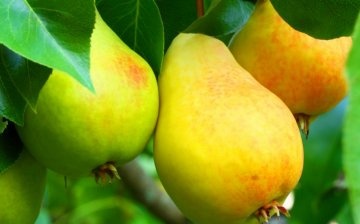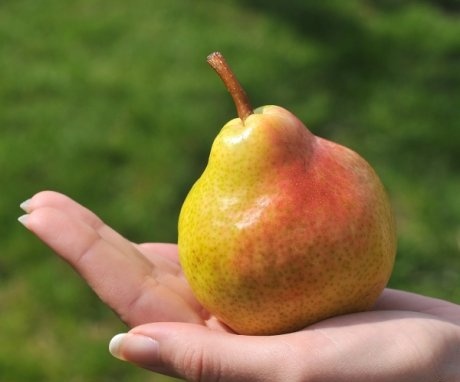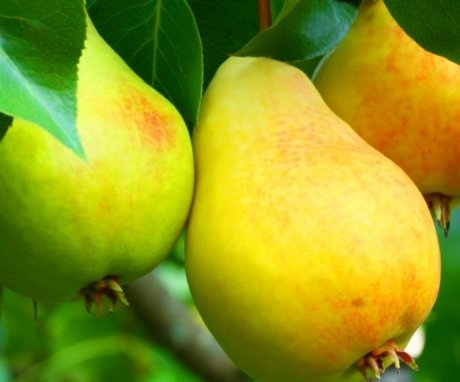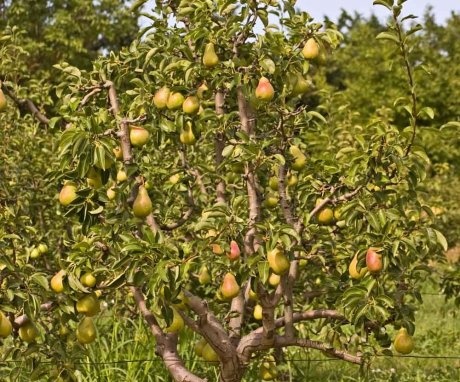Pear Zarechnaya, features of the variety, useful properties of fruits, growing crops
There are many varieties of pears. Each variety has its own advantages, it differs in taste characteristics and the degree of disease resistance.
When choosing a fruit tree, attention is paid to the whimsy of the culture to care. Pear Zarechnaya meets almost all the requirements of gardeners. The features of its cultivation are described in the article.
Features of the variety
The main advantages pears Zarechnaya are considered to be winter hardiness and stable yield.
A brief history of origin, where they grow
The variety is selective, the fruits ripen from late summer to mid-September. In regions with a warm climate, fruiting lasts until early October.
The creators of the variety are breeders of a gardening station located in the Sverdlovsk region. The variety was obtained in 1974 as a result of combining the genetic material of the Rannyaya Milevskaya and Tema varieties. The high taste of fruits and simple rules of agricultural technology were appreciated by amateur gardeners.
Reference! The fruiting period begins 4-6 years after the planting of the seedling. Every year there is a high increase in yield.
Characteristics of trees, shoots, foliage, fruits
The tree has distinctive features. It can be recognized by its compact size, the height of the culture does not exceed 2.5-3 m. The young plant is rapidly gaining growth. In the first 2-4 years, the crown is formed. It is spreading in a pear, round in shape, but not too thick. The leaves are densely located on the branches, making the tree seem airy and light.
Young shoots are placed in an upright position with a slight slope relative to the trunk. On the trunk, the bark has a grayish tint, the branches are brownish-yellowish.
During the flowering period, the tree is covered with white-pink flowers, about which a pleasant aroma emanates. The fruits are formed at the sites of complex ringlets and on spears.
The leaves of the Zarechnaya pear have a slight downward bend. Their shape is elongated-oval, the color is deep green.
Characteristic features of the fruit:
- average weight - 110-115 g;
- the skin is thin, the surface is smooth without grooves;
- golden color;
- pear-shaped;
- thick peduncle.
The peculiarity of the fruits of the Zarechnaya pear variety is that they do not fall off after ripening.
Composition and useful properties of fruits
The pulp contains a large amount of valuable trace elements that are useful for the human body. In addition to glucose, sucrose and fructose, pear is rich in vitamins (B1, B2, E, A, P, PP, C, etc.). Saturated with fruits and other substances:
- potassium;
- nitrogenous compounds;
- calcium;
- tanning components;
- carotene;
- folic acid;
- fiber;
- copper;
- pectins;
- manganese;
- iodine, etc.
Reference! The folic acid index of pears is higher than that of black currants.
Pears are included in dietary meals for various diseases. They are recommended for diabetes mellitus, pancreatic dysfunction, obesity. Delicious fruits help to eliminate toxins and heavy metals from the body.
Taste qualities
Fruit tasting score - 4.3-4.6 points. The fruit tastes sweet with a slight shading sourness. The pulp is juicy without solids, the consistency is homogeneous.
Yield
The pear variety Zarechnaya has a stable yield. The indicator depends on the region of cultivation of the crop and stock.On average, 7.8-9.6 kg of fruit are removed from an adult tree.
Early maturity
The pear variety in question is considered an early autumn variety. The technical ripeness of the fruits occurs at the end of August - mid-September.
Terms of flowering, fruiting and storage
The tree becomes rich in color in May. White-pink inflorescences add extraordinary beauty to the culture. The fruiting period falls in the third decade of August.
Ripe fruits do not fall off the tree, which is a significant plus. Despite the compactness of the plant, harvesting without a stepladder is not realistic. You can stock up on special pullers for garden trees. This will make the process easier and faster.
Reference! Fruits are harvested in dry weather in the afternoon. There is dew on the trees in the morning, so picking pears for long-term storage is not recommended.
For storage, not overripe fruits are selected without signs of damage and disease. Each pear must be wiped with a dry cloth and wrapped in paper. The workpiece is folded into a disinfected box and placed in the cellar. The fruit is periodically revised to identify damaged fruit. They are immediately removed from the container so that the rest do not intercept the rot.
Growing features
Agrotechnology of pears consists of simple measures that are carried out with all horticultural crops.
Landing
The crop responds well to fertile, light-textured soil. The intensive growth of the tree requires unhindered access of oxygen to the roots. To create the most favorable conditions, the soil is pre-fertilized. For this purpose, a mixture of the following components is used:
- fertile soil - 3 parts;
- humus (compost) - 1 part;
- nitrophoska - 100 g;
- potassium salt - 25 g;
- superphosphate - 50 g.
If the soil at the landing site is acidified, it is necessary to neutralize the environment by introducing dolomite flour or wood ash.
Planting a seedling is planned for the fall or spring after the threat of night frosts has passed. You should not transfer the tree to other places after planting, the pear does not like this. Therefore, there is no need to rush to choose a site in the garden.
If planting work is carried out in the spring, then in the fall they are preparing the pit in advance. Recommended parameters:
- depth - 1 m;
- length and width - 70 cm each.
In the center of the pit, a clay bed is made (layer up to 12 cm), then compost is added. After that, the deepening is thrown with a nutritious soil mixture. In this form, the place for the seedling remains until spring.
When planning a landing in the spring, the pit is prepared 3 weeks before the scheduled day. The principle of ditch formation is the same as for autumn works.
Important! A peg is placed in the center of the pit. In the future, it will serve as a support, protecting the young tree from strong winds and precipitation.
The seedlings themselves also need to be prepared. They should have smooth bark without signs of damage, grafted, trunk length - no more than 80 cm. When choosing planting material, special attention is paid to the root system. The main thing is that it does not dry out. Advanced branches on the main spine are encouraged.
The day before planting, the roots of the seedling are soaked in a solution (water plus root stimulant). The same liquid is carried out for the first watering of the tree after it is buried in the ground.
Immediately before planting, the root branches of the seedling are shortened by 12 cm. The stem part is freed from lateral shoots. The tree is set strictly vertically in the hole, the roots are spread and covered with soil mixture. The root collar should rise above the soil level (by 4 cm).
The soil in the trunk circle is carefully trampled down to release excess air. Next, the area around the seedling is mulched, the trunk is fixed to the support and the plant is watered (2 buckets).
Care
Main pear care provides for timely watering, weed removal and loosening of the soil. You need to irrigate the tree at least 1 time per week (for each plant, 1 bucket of water).The absence of weeds prevents decay of the root collar. And thanks to aeration, there is an active movement of nutrients to the roots.
With the adaptation and further development of the seedling, problems will not arise if you periodically add top dressing to the near-stem circle. In the spring, nitrogen compounds are used. In the first and second year after planting, organic matter is introduced. Then the organic feeding regime is changed once every 3-5 years. After the end of the flowering period, the tree is watered with a solution of water and mineral fertilizers. Such recharge is carried out annually.
Reference! It is recommended to apply dry nutrient compositions to the soil in the crown area (not under the root).
In autumn, the pear is insulated to avoid freezing. Burlap, spruce branches and other covering material are used as insulation. In the spring, after the snow melts, the protection is removed to avoid overheating of the bark.
Every year in spring and autumn, the tree is treated with disinfectants to prevent diseases and pests.
Resistant to temperatures
The pear variety Zarechnaya is resistant to low temperatures. In the middle lane without shelter, the tree endures winter with the lowest rates up to minus 20 °. If the climate is more severe, shelters are created.
To diseases and pests
There are no big problems with diseases. The plant shows resistance to common diseases of horticultural crops. But this does not exclude preventive treatments.
Most of the diseases develop against the background of improper care or unfavorable weather. An abundance of moisture provokes fungal infections and viral diseases. Among the dangerous:
- scab - recognized by numerous points, affects the trunk of a tree;
- powdery mildew - appears as a white bloom, affects the entire plant;
- stem rot - occurs due to severe frost or sunburn.
Pests also cause great harm to horticultural crops. Insects are attracted by greenery, fragrant inflorescences. Among the dangerous parasites:
- flower beetles;
- ticks;
- moths;
- silkworm;
- hawthorn;
- pear gall midge, etc.
Measures to protect trees from pests include: installing birdhouses to attract birds, inspecting the trunk in order to identify clutches with eggs. Herbal infusions are also suitable for spraying pears. Recipes for folk insect control methods are easy to find on the Internet.
Reference! Wormwood, onions, garlic, hot peppers and other herbs have deterrent properties.
Insecticides are used along with organic products. They must be used according to the instructions. It is not recommended to exceed the dose, so as not to burn the tree.
The nuances of growing in different regions
Until recently, the pear in the Urals and Siberia was exotic. Now, thanks to the development of frost-resistant varieties, sweet fruits are grown along with apple trees. For a culture to bear fruit, it takes a little effort:
- plan the planting of seedlings in the spring;
- enrich the soil with mineral fertilizers before planting;
- at the end of the season, cut off dried and damaged branches;
- when choosing a top dressing, give preference to a potassium-phosphorus composition;
- for the winter, trees need to be treated with special agents to protect against insects and diseases;
- wrap a young tree with agrofibre (burlap, spruce paws) so that the plant does not freeze;
- cover the trunk circle with peat or dry leaves.
In regions with less harsh climates, it is not necessary to create protection for the winter. The frost resistance of the variety will help to cope with cold weather. The rest of the rules of agricultural technology are carried out in full. Planting with a seedling is possible both in spring and autumn.
Reference! Pears growing in warm regions need more watering. Irrigation mode: 1 time per week (bucket of water). In the northern regions, it is enough to moisten the soil 2-3 times a month.
Possible problems with the variety and ways to solve them
In general, the agricultural technology of culture is simple.However, not a single plant is insured against diseases and insect infestations. Pear Zarechnaya is no exception.
Gardeners when growing fruit trees may face the following problems.
- Insufficient watering can cause the tree to shed its foliage. If this has already happened, you need to introduce a liquid enriched with mineral fertilizers into the trunk circle. For 2-3 weeks, resume daily irrigation, but do not allow stagnation of moisture in the soil.
- Spring and autumn treatments with lime mortar will help protect the trunk from damage by pests. Many gardeners find damaged bark after opening the protective material in the spring. Under the shelter, insects and harmful microorganisms perfectly tolerate the winter cold, and they use the living tissues of the trunk as food.
- It so happens that after a rapid flowering, a large number of ovaries fall off. Possible causes include pests, excess or lack of moisture, and nutritional deficiencies. To eliminate the problem, it is recommended to revise the irrigation regime, the introduction of dressings. You also need to take preventive measures against diseases by spraying the crown with insecticides.
Advantages and disadvantages of the variety
The pear variety is popular among gardeners and farmers in Russia. Interest in culture is due to the following advantages:
- winter hardiness;
- unpretentious care;
- stable yield;
- the pulp does not contain stony cells;
- presentation of pods;
- after reaching technical ripeness, pears do not fall from the tree;
- high taste of fruits.
In fairness, it is worth mentioning the shortcomings. Among the essential:
- the variety is not fast-growing;
- medium scab resistance;
- exactingness to a humid environment (with a moisture deficit, the tree sheds foliage).
Pollinator varieties
The predominant number of pear varieties are self-fertile, therefore high-quality pollination is required. If this is not done, the fruits will not tie after flowering. The best pollinators are those varieties of pears that bloom at the same time as Zarechnaya. These cannot be early flowering crops, since the flowering times do not coincide.
Not every plant can function as a pollinator. The following varieties of culture are recommended for Zarechnaya:
- Chizhovskaya;
- Severyanka;
- Space.
Testimonials
- Tamara, Kursk region
At the dacha there is not so much space for a garden, therefore, when choosing seedlings, I was guided by one criterion - the plants should be compact in size. Pear Zarechnaya grows up to 3 meters. The crown is round, but with proper care it does not interfere with the growth of neighboring crops. Beginning to bear fruit in the 5th year after disembarkation. Only 3 fruits were set. The next year, the harvest was already 1.6 kg. I often go to the city for 2-4 weeks. During the absence, nothing terrible happens to the garden.
- Semyon Alekseevich, Perm Territory
The son brought 5 seedlings of pears from Zarechnaya from the Urals, where he lives with his family. In the fall, young trees were planted, only 3 trees survived the harsh winter. The culture is growing rapidly, by the first autumn the height has exceeded 1.8 m. In the fourth year, the first fruits have already been tasted. On each tree, 4-7 of them were tied. Now the trees are 6 years old. In total, 4 boxes were assembled during the season (4.8 kg each). The peculiarity of the variety is that it requires timely watering. I went to the sea, and upon arrival I saw almost completely bald trees. Barely came out of them.
- Roza Andreevna, Kemerovo
On the site I grow pears Zarechnaya, Permyachka and Penguin. In terms of taste, I like Zarechnaya more. She is unpretentious in care, and insects do not strongly cling to her. During 12 years of cultivation of the garden there were no diseases. The yield of the variety is stable. The tree tolerates winter well, especially late spring frosts.
Watch a video about the best pear varieties with tips for choosing them:












In our garden, there is such a pear.Such long-term fruiting, contributes to the fact that often pears begin to deteriorate even on the branches of the tree. In addition, the pear, for some reason, bears fruit in the garden after a year.